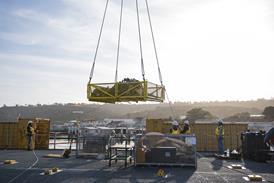Paul Lewis/WASHINGTON DC
The US National Transportation Safety Board (NTSB) hopes the impending recovery of EgyptAir flight 990's cockpit and data recorders will shed light on the Boeing 767-300ER's rollercoaster plunge into the sea on 31 October.
NTSB investigators were waiting for a break in stormy weather last week to deploy a remotely piloted submersible to recover the flight data and cockpit voice recorders (FDR and CVR). Locator signals from the two boxes have been detected in a debris field 75-85m (250-275ft) beneath the ocean, 93km (50nm) south of Nantucket Island.
The CVR will be critical in determining what happened in the cockpit after Flight 990's last routine communication, almost seven minutes before the aircraft's sudden dive.
The 10-year-old 767 had also been retrofitted with a more modern 55-parameter FDR, which should determine the position of the jet's thrust reversers.
Much speculation has been generated by news that the aircraft's port reverser had been deactivated after earlier problems.
The Egyptian jet was the 282nd 767 built, next in line to the Lauda Air aircraft that crashed in Thailand in May 1991. That accident was attributed to the deployment of a thrust reverser during a full thrust climb at 10,000ft, sending the jet into an unrecoverable roll.
Unlike the Lauda Air aircraft, the EgyptAir 767 had reached cruise at 33,000ft and its twin engines would have been throttled back. "We have no evidence at this time that the thrust reverser system played any role in this accident," says NTSB chairman Jim Hall.
According to a composite of nine separate radar returns, the aircraft appears to have dived at high speed in a straight line for around 40s until reaching 16,700ft. It then turned to the right and climbed back to 24,000ft before resuming its dive 37s later.
Different explanations have been offered for this 'porpoise' action. These include a possible attempt by the pilots to recover the aircraft or a natural aerodynamic reaction to the jet's high speed.
The 767 appears to have broken up at 10,000ft once the aircraft encountered the thicker atmosphere and exceeded its structural limits.
Small pieces of the aircraft have been recovered from the sea surface, including cabin interior fittings, a spoiler panel, nose gear and part of a main wheel and engine cowling.
The dead total 217 crew and passengers, including a group of senior Egyptian military officers. There is no evidence so far of terrorist action, say officials.
Source: Flight International























